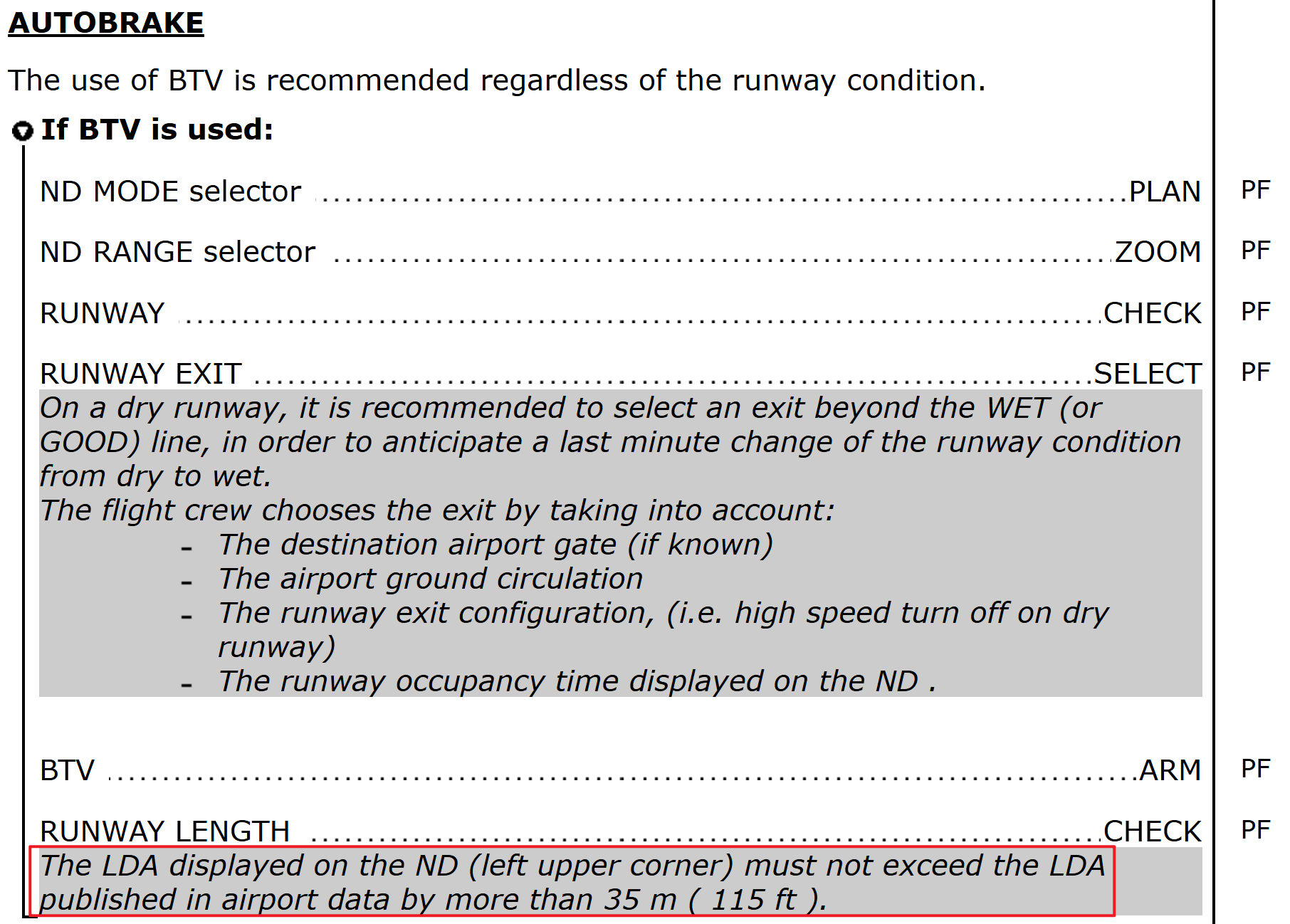在下降准备中,设置要检查 ND 上的可用着陆距离不能超过航图上 35m:
什么情况下,ANF 数据库中的 LDA 会和航图上的不一致呢?如果是跑道缩减导致的,为什么不能直接去修改 ANF 数据库中的 RWY SHIFT?这个 35m 的数值又是一句什么来定的呢?
空客解释两个数据库距离的偏差可能是由于 ANF 数据库 LDA 数据编码错误/过期,或者是临时跑道內移造成的。编码错误会影响 BTV 使用。
而如果跑道有临时內移,应该先在 ANF 数据库中做相应的修改,再对比修改后的 LDA 与航图上的 LDA,而不是直接对比。如果 ANF 数据库中修改了shift的 LDA 比航图减去临时內移后的 LDA 还多 35m 以上,则不能使用 BTV。
至于 35m 的来源,空客没有具体解释,只是说这是一个为了防止冲出跑道的安全裕度。如果误差超过 35m,则说明 ANF 数据库整体上存在不准确性,此时不应使用 BTV。
原文:
Q1
As FCOM PRO-NOR-SOP-160 A DESCENT PREPARATION - AUTOBRAKE:
"The LDA displayed on the ND (left upper corner) must not exceed the LDA published in airport data by more than 35 m (115 ft)."
Under what circumstances would there be a difference between the LDA on ND and published in airport data? Is it due to an inconsistent database cycle, or a temporary runway shift?
Where does the figure of 35 meters come from?
If it is because of a temporary runway shift, and even if it exceeds 35 meters, couldn't it be just modified in ANF database by crew? Why is a limit value of 35 meters set?
A1
Please be informed that the difference between the LDA displayed on the ND versus airport chart can be due to a wrong/outdated coding of the LDA in the ANF database or temporary runway shift. Therefore, the SOP asks the flight crew to check that the runway length coded in the ANF database and the data from the chart are consistent.
On the A350, a wrong coding of the LDA in the ANF database will affect the BTV function only (and not BRK MED or manual braking). Even though ROW/ROP remains available in these conditions (and will trigger the appropriate alerts if necessary), BTV should not be used if the ANF LDA exceeds the published LDA by more than 35 m (115 ft). The 35 m value is the margin to prevent a runway excursion.
We would like to inform CSC that a discrepancy of more than 35 m indicates a global inaccuracy of the ANF data for this runway, and that in this case BTV should not be used. In the case when a shortening is entered (in fact the runway length reduction is applied from either from the runway threshold or runway end) then the reference data should be correct.
Q2
Does this mean, if there is a temporary runway shift, it would be more appropriate to first make the corresponding modifications to the temporary shift in the ANF database, and then compare the modified ANF LDA with the LDA from the charts after subtracting the temporary shift.
If, after the modification, the LDA in the ANF database still exceeds the chart's LDA (after subtracting the temporary shift) by more than 35 meters, then the BTV function should not be used. This is because such a discrepancy indicates a potential global inaccuracy in the database, compromising the reliability of BTV operations and safety.
A2
Your understanding is correct.
In case of known runway length reduction not correctly coded in the ADB, the flight crew should use the “MODIFY RUNWAY” function of the ANF to manually enter the appropriate shift (either from runway threshold or runway end). This ensures a correct functioning of ROW/ROP/BTV.
As per Airbus SOP, BTV should not be used if the ANF LDA exceeds the published LDA by more than 35 m (115 ft).

